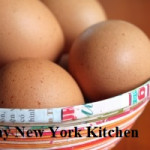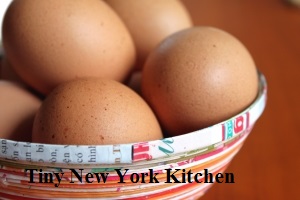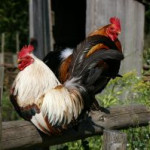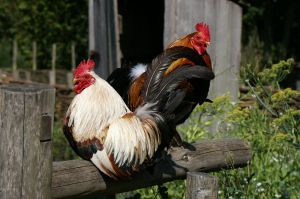Do not transfer your eggs to the egg holder in the refrigerator door. This is actually the warmest place in the fridge and storing them there will hasten spoilage. Leave them in their carton and put them on a shelf.
There is no difference in flavor or nutritional value between white and brown eggs. Choosing one over the other is a matter of aesthetic preference. The breed of chicken determines the color of the eggshell.
To crack an egg with a clean break, rap it on a flat work surface. Eggs that are cracked on the edge of a bowl shatter more easily and you can end up with pieces of eggshell in the bowl.
Eggs are much easier to separate when they are cold. Most chefs learn to separate eggs by passing their contents back and for between halved shells, but this is not the greatest method as the sharp shells can cut into the yolk. It’s much better to use your hands. Working over a bowl, hold the egg in one hand and rap the egg on the work surface. Still using one hand crack the egg into your other cupped free hand. With practice you will soon be able to crack and open an egg with just one hand. Throw away the shell. Gently pass the egg back and forth to your cupped hands. Let the white slip through your fingers into the bowl while the yolk remains intact. Make sure to wash your hands well before starting this process and, of course, after you’ve separated the last egg.
Room temperature eggs will beat more easily because they will incorporate more air than cold eggs. To take the chill off of refrigerated eggs put the uncracked egg in a heatproof bowl and then add hot tap water to cover. Let stand for about 5 minutes.
To bring egg whites to room temperature, separate the cold eggs. Open them over a heatproof bowl so that the whites fall into it. Put the bowl in a larger bowl filled with hot tap water and let stand. Stir occasionally for about 3 minutes or just until the whites lose their chill.
Fat inhibits the aerations of egg whites. When you are beating egg whites make sure that there is not ANY fat that comes in contact with the whites. Bowls and beaters must be absolutely clean. Do not use a plastic or rubber bowl for beating egg whites because they seem to retain grease. To make sure that you have removed all grease from the bowls and beaters put the beaters in the bowl and add a generous splash of vinegar. Wipe out the bowl with paper towels and then wipe down the beaters with the vinegar soaked paper towels. Pour out any vinegar that may remain in the bowl, but do not rinse out the vinegar residue. Due to its acidity, vinegar will react with the egg whites and help them hold their shape when whipped.
For soft scrambled eggs, add a spoonful of heavy cream or milk when you beat the eggs. This should be about 1 tablespoon for every 2 eggs. Salt does toughen the eggs so don’t add the salt until after the eggs are cooked.
Poached eggs should have an attractive oval shape. First, use very fresh eggs, as their whites are firmer than older eggs. Regardless of age, it isn’t easy to get the whites to behave in simmering cooking water. Vinegar and salt will help set and control the spreading whites. Add 1 tablespoon of cider or distilled vinegar and 1/2 teaspoon of kosher salt to every quart of water. When the eggs are done, use a slotted spoon to transfer them to a bowl of hot tap water to rinse off the vinegar flavor and to hold the eggs for a few minutes before serving.
Hard-boiled eggs should be easy to cook. There are two common problems in cooking hard-boiled eggs. 1. Green-ringed yolks 2.Difficulty peeling. First, you should use eggs that have been stored for 7 to 10 days before cooking them. Older eggs are easier to peel. As the egg ages, carbon dioxide escapes through the shell, reducing the acidity of the white and acidity affects how the white clings to the shell. For peeling I find it easier to peel a hard-boiled eggs under running water.
Despite common belief, hard-boiled eggs should not be boiled for two reasons. First of all, the bubbling water can move the eggs so much that the shells crack. Second, it is easy to overcook eggs in boiling water. Overcooking will cause that horrible green ring that sometimes forms around the yolk. A better and easier way to cook the eggs is by putting them in a saucepan and cover with cold water. Bring to a simmer over a high heat. Take the pan off of the heat and cover with a lid. Let the egg stand in the water for 15 minutes. Pour off most of the water from the saucepan and then fill the pan with cold water. Let the eggs stand until they are completely cooled which should be for about 20 minutes. Crack and peel the eggs (under running water) immediately after cooling.
I have loved chickens for many years. Twenty years ago I had a chicken coop built on my property where I lived in the Pacific NW. I raised laying hens so that I could cook with fresh eggs. During the day I let my hens roam my property and at dusk my son’s corgi would herd them into their coop. Each morning I would go out to the coop, thank the “girls” and gather beautiful fresh eggs. Those days are gone and I now live a much different life dividing my week between my apartment in New York City and my house in Fairfield County.
Here are some fun and interesting chicken facts:
Chickens are omnivores. In the wild they will scratch the soil searching for seeds, insects, young mice and lizards.
Alektorophobia means “fear of chickens.”
The older the hen the larger the eggs she lays.
Chickens with white earlobes lay white eggs. Chickens with red earlobes lay brown eggs.
Chickens can live for 5 to 10 years depending on the breed. According to, The Guinness Book of World Records, the world’s oldest chicken died of heart failure at age 16.
A fresh egg sinks in a bowl of water, and old egg floats.
Hens start clucking to the eggs a few days before hatching, making it more likely that they will all hatch at approximately the same time.
DNA evidence suggests that chickens are the closest living relatives to the Tyrannosaurus Rex.
The first pictures of chickens in Europe were found on 7th Century BC Corinthian pottery.
Eggs dry out more quickly in your refrigerator’s egg rack so it is best to leave them in the carton.
If you can’t remember which eggs you cooked then spin them. If an egg spins quickly then it is hard boiled. If an egg spins slowly and wobbles then it is raw.
It is estimated that there are four chickens to every human on the planet.
The egg carton was invented in 1911 by a Canadian newspaper editor named, Joseph Coyle, in Smithers, British Columbia
An egg standing on its end can bear up to 200 pounds. The record was set by the Ontario Science Centre.
For best results, eggs should be brought to room temperature when used for baking.
A plastic egg, golf ball or avocado pit placed in a nest will encourage a hen to lay in it. This is the origin of the term “nest egg.”
“Go away, boy! Or I’ll spank you where the feathers are the thinnest.” – Foghorn J. Leghorn









